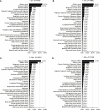Cause-Specific Mortality Among Survivors From T1N0M0 Renal Cell Carcinoma: A Registry-Based Cohort Study
- PMID: 33777747
- PMCID: PMC7988093
- DOI: 10.3389/fonc.2021.604724
Cause-Specific Mortality Among Survivors From T1N0M0 Renal Cell Carcinoma: A Registry-Based Cohort Study
Abstract
Objective: More T1N0M0 renal cell carcinoma (RCC) is detected and the prognosis has improved, but, the current focus on non-RCC-related mortality is superficial. We investigated cause-specific mortality and its temporal patterns after an RCC diagnosis.
Methods: In the Surveillance, Epidemiology, and End Results-18 database, patients with T1N0M0 RCC treated with partial nephrectomy (PN) or radical nephrectomy (RN) during 2000-15 were identified. Standardized mortality ratios (SMRs) for cause of death were calculated. Risk predictors for each cause-specific mortality were investigated using the Fine and Gray sub-distribution model.
Results: In all, 68,612 eligible patients were pooled. A total of 14,047 (20.5%) patients had died (cardiovascular disease [CVD], 28.3%; other non-cancer-related diseases, 20.3%; RCC, 18.7%; other cancer types, 16.3%; non-disease events, 16.1%) during follow-up. Heart disease, diabetes mellitus, and cerebrovascular disease were the primary causes of non-RCC-related mortality within 1 year after the diagnosis. The greatest proportion of death (39.0%) occurred within 1-5 years after the diagnosis, mostly due to RCC itself, followed by heart disease. However, >5 years after the diagnosis, heart disease became the leading cause of death. Compared with the general US population, a 21% (SMR, 1.21; 95%CI 1.19-1.23) increased risk of all-mortality was observed; RCC patients had a higher risk of heart disease-related death within 5-10 years (SMR, 1.10; 95%CI 1.04-1.17) and >10 years (1.12; 1.02-1.22) after the diagnosis. Older age and RN increased the death risk of CVD and RCC-specific mortality. Although a larger tumor diameter increased the risk of RCC-specific death, this was not a significant predictor for CVD. Moreover, for T1N0M0 RCC tumors of diameter >4 cm, there was no significant difference in CVD incidence for RN vs. PN.
Conclusions: RCC-specific mortality is a common challenge for the prognosis. Importantly, a large proportion and higher SMRs of other non-RCC-related diseases (especially CVD) should not be disregarded for the better holistic management of survivors of local RCC. Targeted prevention strategies for non-RCC-related death could lead to significant reductions in mortality for RCC survivors.
Keywords: competing mortality; long-term survival; prognosis; renal cell carcinoma; standardized mortality ratio.
Copyright © 2021 Wang, Wang, Zhu, Liu, Li and Zeng.
Conflict of interest statement
The authors declare that the research was conducted in the absence of any commercial or financial relationships that could be construed as a potential conflict of interest.
Figures




Similar articles
-
Local ablation vs partial nephrectomy in T1N0M0 renal cell carcinoma: An inverse probability of treatment weighting analysis.Cancer Med. 2020 Nov;9(21):7988-8003. doi: 10.1002/cam4.3433. Epub 2020 Sep 5. Cancer Med. 2020. PMID: 32888392 Free PMC article.
-
Cause of Death During Renal Cell Carcinoma Survivorship: A Contemporary, Population-Based Analysis.Front Oncol. 2022 Jun 2;12:864132. doi: 10.3389/fonc.2022.864132. eCollection 2022. Front Oncol. 2022. PMID: 35719910 Free PMC article.
-
Partial versus radical nephrectomy for T1b renal cell carcinoma: A comparison of efficacy and prognostic factors based on the Surveillance, Epidemiology, and End Results database.Curr Urol. 2024 Dec;18(4):328-335. doi: 10.1097/CU9.0000000000000229. Epub 2023 Nov 3. Curr Urol. 2024. PMID: 40256286 Free PMC article.
-
Cardiovascular mortality in people with cancer compared to the general population: A systematic review and meta-analysis.Cancer Med. 2024 Aug;13(15):e70057. doi: 10.1002/cam4.70057. Cancer Med. 2024. PMID: 39096123 Free PMC article.
-
Partial Versus Radical Nephrectomy in Patients with Renal Cell Carcinoma: A Systematic Review and Meta-analysis.Urol J. 2020 Mar 16;17(2):109-117. doi: 10.22037/uj.v0i0.5358. Urol J. 2020. PMID: 32180211
Cited by
-
Comparison of prognosis between patients undergoing radical nephrectomy versus partial nephrectomy for renal cell carcinoma ≤7 cm T3aN0/xM0: Survival benefit is biased toward partial nephrectomy.Cancer Med. 2021 Dec;10(24):8909-8923. doi: 10.1002/cam4.4412. Epub 2021 Nov 14. Cancer Med. 2021. PMID: 34779154 Free PMC article.
-
Cardiovascular Disease and Other Competing Causes of Death in Older Kidney Cancer Patients.Rev Cardiovasc Med. 2025 Jan 14;26(1):25277. doi: 10.31083/RCM25277. eCollection 2025 Jan. Rev Cardiovasc Med. 2025. PMID: 39867178 Free PMC article.
-
MiRNA-148a inhibits cell growth and drug resistance by regulating WNT10a expression in renal cell carcinoma.Transl Androl Urol. 2022 Jul;11(7):996-1006. doi: 10.21037/tau-22-464. Transl Androl Urol. 2022. PMID: 35958896 Free PMC article.
-
Long-Term Survival of Patients with Stage T1N0M1 Renal Cell Carcinoma.Cancers (Basel). 2023 Dec 6;15(24):5715. doi: 10.3390/cancers15245715. Cancers (Basel). 2023. PMID: 38136261 Free PMC article.
-
Standardized Incidence Rate, Risk and Survival Outcomes of Second Primary Malignancy Among Renal Cell Carcinoma Survivors: A Nested Case-Control Study.Front Oncol. 2021 Jul 30;11:716741. doi: 10.3389/fonc.2021.716741. eCollection 2021. Front Oncol. 2021. PMID: 34395291 Free PMC article.
References
LinkOut - more resources
Full Text Sources
Other Literature Sources

